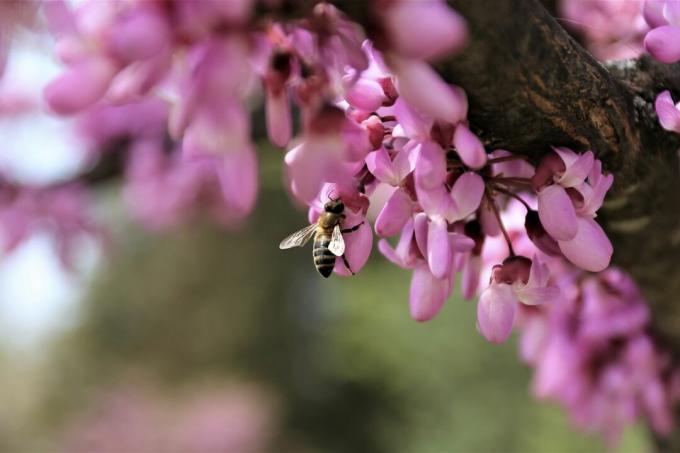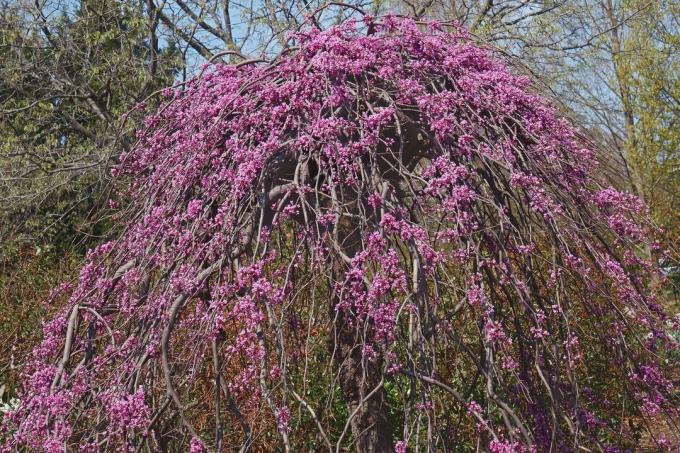Already in April and May, even before they bear leaves, the Judas trees unfold their blooms. Read with us where the trees come from and how to care for them properly.

Not only because of their beautiful flowers, but also because of their special autumn colors, Judas trees are colorful plants for the home garden. We will explain to you what distinguishes the legume family, what types and varieties there are and what needs to be considered when planting.
contents
- Judas tree: leaves, flower and properties
- The most beautiful Judas tree varieties and species
- Planting a Judas tree: location and procedure
- Care of the Judas tree: pruning, fertilizing and Co.
- Grow Judas Tree
- Is the Judas tree hardy?
- Common pests and diseases
- Is the Judas tree poisonous?
Judas tree: leaves, flower and properties
Judas trees (Cercis) in the garden. The plant genus forms its flowers on old stem parts and not on young wood, as is the case with most flowering trees and shrubs. Judas trees have different regional names and are also called love tree or salad tree. The genus of the Judas trees belongs to the family of the legumes (Fabaceae). The species that we plant most frequently, the common Judas tree (
Cercis siliquastrum), originally comes from the Mediterranean region in southern Europe and the Near East. This supports his name legend, but it is dark: After Judas Iscariot betrayed Jesus to the Romans, he hanged himself on one of the trees, causing the tree to turn red in shame. Other species from North America and Central Asia are also common here today.Judas trees grow as deciduous shrubs or multi-stemmed trees that typically reach heights of 4 to 8 meters, although dwarf forms also exist. Because of the deep-reaching main root and weakly developed fine and side roots, the Judas tree can only be planted in a bucket for young plants. The bark has an olive-brown to black-brown color and is usually cracked, furrowed or scaly. The alternate, heart- or kidney-shaped leaves, which have a thin leaf blade, are striking.

Before the leaves sprout, the Judas tree flowers from April to May. The short, racemose inflorescences consist of up to ten individual flowers, which are striking due to their five reddish to purple, bell-shaped fused sepals. The five purple to pink petals and the ten uniform anthers are more subtle. Naturally, the Judas tree is pollinated by insects such as bees. From the flowers up to 10 cm long, banana-shaped legumes are formed, which a variety contain small, egg-shaped seeds and, because of their light weight, are carried by the wind spread.
The most beautiful Judas tree varieties and species
There are three types of Judas tree that we use in gardens: the common Judas tree, which we plant most frequently (Cercis siliquastrum), also called common Judas tree, the American or Canadian Judas tree (C canadensis) and the Chinese Judas tree (C chinensis). The leaves of the common and Chinese Judas tree have a bronze hue when they emerge, during the vegetation they are green and finally get the well-known Judas tree autumn coloring in strong shades of yellow. The leaves of Canada Judas trees are tinged dark red during vegetation and turn bright yellow in fall.
For each of the three types there are in turn some varieties that are very popular because of their different properties:
- Ordinary Judas tree ‘Alba‘: Widespread variety here, only grows to a maximum height of 2.5 m, green leaves and white flowers, needs protection from frost, especially when young.
- Ordinary Judas tree ‘Rubra‘: Up to 8 m tall, strong dark red flowers, grey-green leaves, frost protection is necessary, especially when young.
- Canadian Judas Tree ‘Merlot‘: Grows up to 4 m high, special play of colors due to foliage and flowers, dark red color of the leaves is reminiscent of the red wine Merlot.
- Canadian Judas Tree ‘Ruby Falls‘: Up to 4 m tall, hanging Judas tree, strong red foliage, purple flowers from April, very dense inflorescence, very frost hardy.
- Canadian Judas Tree 'Hearts of Gold‘: Grows to around 4 m tall, golden-yellow leaves and whitish-purple flowers, not very frost hardy.
- Chinese Judas Tree ‘Avondale‘: Grows to 2.5 m tall, purplish-red flowers, leaves are green during vegetation and turn rich yellow in fall.

Planting a Judas tree: location and procedure
The Judas tree grows naturally in sparse forests or as pioneer vegetation on calcareous soils at altitudes of less than 400 meters. In the home garden, sandy, well-drained soil is ideal. Moderately dry to dry soils are just right for the Judas tree. The lime-loving plant also tolerates weakly acidic soils, although adding lime when planting is very beneficial. Very heavy, clay-rich soils as well as very humus-rich soils should be improved by adding sand extensively and deeply. Full sun to sunny, wind-protected locations are well suited for the Judas tree.
The best time for planting is spring, as soon as frost can be ruled out. To plant the Judas tree in the garden, a hole can be dug with a spade, the plant ball inserted and covered with soil. As a rule of thumb, the hole should be about 1.5 times as wide and as deep as the bale. Lightly pressing and watering well, preferably using a casting ring around the trunk, promotes the growth of the Judas tree. Tall trunks and large Judas trees should be tied to two stakes so that the movement of the trunk above ground does not impede growth. The tree is only suitable as a young plant for keeping in a bucket, since the Judas tree is a deep-rooted plant and hardly ever forms secondary or fine roots. With the right pruning, a standard Judas tree can also be grown from most varieties. The Judas tree bonsai is also well suited for lovers of bonsai, because this art form also succeeds with a targeted cut and the right care.

Care of the Judas tree: pruning, fertilizing and Co.
The Judas tree is a very easy-care plant. A cut is rarely necessary, as the large shrub naturally grows very picturesquely and a cut would destroy this appearance. If necessary, the Judas tree can be cut in the fall after the end of vegetation. You should cut off a maximum of one third of the length of the shoot, as it does not tolerate cutting too hard. Dead plant parts, on the other hand, can be removed regularly. Because of the deep-reaching main root, the Judas tree is able to mobilize nutrients from deep layers of the soil and therefore does not need additional fertilization. Watering is usually not necessary either, as the plant withstands extreme heat and shorter dry periods without any problems thanks to its root system. It should only be watered during longer dry periods.
tip: The roots of the newly planted Judas tree are not yet sufficiently developed to be able to absorb all the important nutrients from the soil. In order to provide it with the best possible nutrients, you can use a long-term fertilizer like ours for the Judas tree Plantura organic universal fertilizer fertilize.

Grow Judas Tree
Unfortunately, the propagation of the Judas trees is not always successful, since germination is inhibited by a hardened seed coat. The seeds should be sown again in autumn, immediately after they have ripened. To do this, the seeds should be soaked in water for about a day and then placed in potting soil. In a bright place and using a seed tray, with regular watering there is a chance that the Judas tree seeds will germinate. Approximately 10 cm tall young plants should be pricked out and continue to be watered regularly.
Alternatively, in summer, branch cuttings about 15 cm long can be cut off at an angle with a sharp knife and placed about 5 cm deep in potting soil. If the soil is kept well moist, the Judas tree will grow new roots in a bright place after a while. As soon as new shoots are formed, the cutting can be repotted and grown into a young plant. But be careful: the young plants are very sensitive to cold and should stay indoors, especially during the winter.
Is the Judas tree hardy?
The Canadian Judas tree often tolerates cold without any problems. However, the common Judas tree, especially as a young plant, must be protected outdoors with a fleece or lime paint for the first three to five years. Otherwise the cold can lead to frost cracks on the trunk and branches. It is advisable to plant the young plants in pots before they are later planted outdoors, as this allows them to move to a frost-free winter quarters in winter. Only cool places are suitable as winter quarters, because the Judas tree needs cold temperatures to activate its buds for the coming year. The tree overwinters safely and naturally at 0 to 5 °C in a bright shed, garage or unheated greenhouse. As soon as longer periods of frost are no longer to be expected, the young Judas tree can be brought outside again. Older plants can survive the winter outside without hesitation, as they are usually hardy and frost-resistant.

Common pests and diseases
In general, the Judas tree has no problems with diseases and pests. Wilting occurs very rarely due to an infestation with the verticillium-Fungus that clogs the water-carrying vessels, the so-called xylemes, causing individual leaves, branches or the entire tree to wilt. But when the Judas tree shows withered leaves, it is often too late. Only a radical pruning can then possibly help the tree.
Is the Judas tree poisonous?
Judas trees are typically used as ornamental trees, however their flowers are edible raw and have a slightly sweet and sour taste. They are therefore the ideal edible decoration for salads. The flower buds can also be pickled and used as a spice. Legumes, on the other hand, are slightly poisonous and should therefore not be eaten.
Are you looking forward to different flower colors in spring? Then also read our article about bright yellow flowers winter jasmine.
